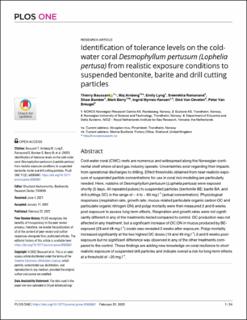| dc.contributor.author | Baussant, Thierry | |
| dc.contributor.author | Arnberg, Maj | |
| dc.contributor.author | Lyng, Emily | |
| dc.contributor.author | Ramanand, Sreerekha S. | |
| dc.contributor.author | Bamber, Shaw Duncan | |
| dc.contributor.author | Berry, Mark | |
| dc.contributor.author | Hansen, Ingrid Myrnes | |
| dc.contributor.author | Van Oevelen, Dick | |
| dc.contributor.author | Van Breugel, Peter | |
| dc.date.accessioned | 2022-07-14T10:33:27Z | |
| dc.date.available | 2022-07-14T10:33:27Z | |
| dc.date.created | 2022-05-02T08:29:09Z | |
| dc.date.issued | 2022 | |
| dc.identifier.issn | 1932-6203 | |
| dc.identifier.uri | https://hdl.handle.net/11250/3005384 | |
| dc.description.abstract | Cold-water coral (CWC) reefs are numerous and widespread along the Norwegian continental shelf where oil and gas industry operate. Uncertainties exist regarding their impacts from operational discharges to drilling. Effect thresholds obtained from near-realistic exposure of suspended particle concentrations for use in coral risk modeling are particularly needed. Here, nubbins of Desmophyllum pertusum (Lophelia pertusa) were exposed shortly (5 days, 4h repeated pulses) to suspended particles (bentonite BE; barite BA, and drill cuttings DC) in the range of ~ 4 to ~ 60 mg.l-1 (actual concentration). Physiological responses (respiration rate, growth rate, mucus-related particulate organic carbon OC and particulate organic nitrogen ON) and polyp mortality were then measured 2 and 6 weeks post-exposure to assess long-term effects. Respiration and growth rates were not significantly different in any of the treatments tested compared to control. OC production was not affected in any treatment, but a significant increase of OC:ON in mucus produced by BE-exposed (23 and 48 mg.l-1) corals was revealed 2 weeks after exposure. Polyp mortality increased significantly at the two highest DC doses (19 and 49 mg.l-1) 2 and 6 weeks post-exposure but no significant difference was observed in any of the other treatments compared to the control. These findings are adding new knowledge on coral resilience to short realistic exposure of suspended drill particles and indicate overall a risk for long-term effects at a threshold of ~20 mg.l-1. | en_US |
| dc.language.iso | eng | en_US |
| dc.rights | Navngivelse 4.0 Internasjonal | * |
| dc.rights.uri | http://creativecommons.org/licenses/by/4.0/deed.no | * |
| dc.title | Identification of tolerance levels on the coldwater coral Desmophyllum pertusum (Lophelia pertusa) from realistic exposure conditions to suspended bentonite, barite and drill cutting particles | en_US |
| dc.title.alternative | Identification of tolerance levels on the coldwater coral Desmophyllum pertusum (Lophelia pertusa) from realistic exposure conditions to suspended bentonite, barite and drill cutting particles | en_US |
| dc.type | Peer reviewed | en_US |
| dc.type | Journal article | en_US |
| dc.rights.holder | © 2022 Baussant et al. | en_US |
| dc.description.version | publishedVersion | en_US |
| cristin.ispublished | true | |
| cristin.fulltext | original | |
| cristin.qualitycode | 1 | |
| dc.identifier.doi | 10.1371/journal.pone.0263061 | |
| dc.identifier.cristin | 2020482 | |
| dc.source.journal | PLOS ONE | en_US |
| dc.source.volume | 17 | en_US |
| dc.source.issue | 2 | en_US |

